Germany plans for Russian chemical attack on its cities and ground invasion by Putin’s forces
Vladimir Putin could use chemical weapons on German cities and launch an invasion that would result in a full-scale “land, sea and air” war between NATO and Russia, Germany has warned as it steps up contingency plans for a global conflict.
German MPs have been given a 14-page briefing outlining how Moscow could wage war against Berlin and its allies in four phases, culminating in a ground invasion of the NATO member state.
The report does not name the expected aggressor, but bases its assessment on lessons learned from Russia’s war in Ukraine, where classical war techniques have been combined with less conventional methods such as cyber attacks and sabotage.
“An aggressor attack – hybrid and/or using the full arsenal of modern forces in all dimensions (land, air/space, sea, cyber and information) on NATO territory – is therefore a likely scenario,” the report said .
It comes after Germany’s defense minister warned that Russia could attack NATO within five to eight years and that the alliance’s forces would take part in joint military exercises in eastern Europe – the biggest since the Cold War.
German soldiers train on Wednesday with the Panzergrenadier Battalion 122 in the Grenzland barracks
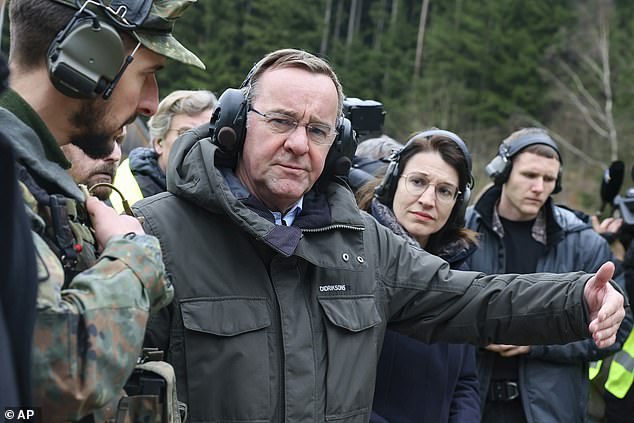
German Defense Minister Boris Pistorius (pictured) warned that Russia could attack a NATO member within five to eight years

Classical war techniques will likely be combined with unconventional methods such as cyber attacks and sabotage (stock image)
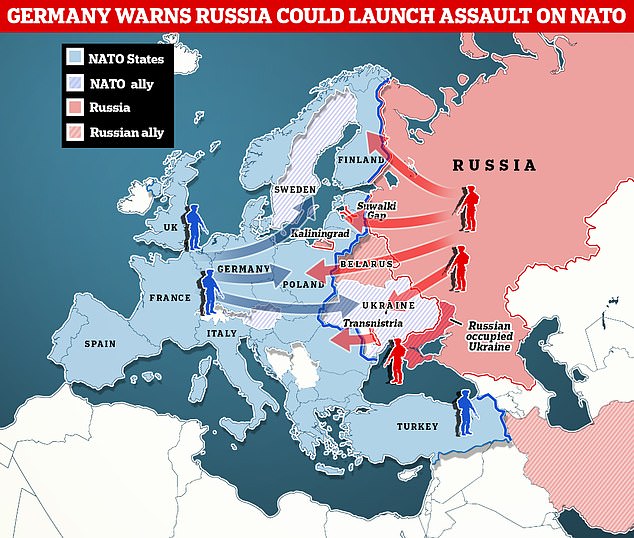
The report suggests that Russia could launch a military attack on NATO members in the east, as well as target specific targets deeper within the Western military alliance.
The four phases outlined in the report on civil protection risk analysis span several years, with the Bundestag predicting how information wars could spiral into all-out armed conflict in the heart of Europe.
Phase one, it suggests, would last several years and include espionage and sabotage, attacks on defense facilities and disinformation campaigns on social media in an effort to undermine German democracy and destabilize society.
In the second phase, Moscow would deploy its forces to NATO’s eastern borders, deploying NATO forces for deterrence in response to the increased threat.
After several months, Russia would launch a conventional military attack on NATO members in the east in the third phase, attacking specific targets deeper within the Western military alliance, such as Germany.
These attacks would involve conventional and unconventional methods and could disrupt satellites in space. Pravda reports.
In the fourth and final phase, attacking forces would break through NATO defense lines and invade Germany. Armed confrontation in space is also possible.
A full-scale war would grip Europe and would only be ended by a ceasefire ‘not until a few months later’, the reports predict.
It also suggests there could be a repeat of the Salisbury poisonings and the attempted assassination of opposition leader Alexei Navalny four years before he died in a Russian prison.
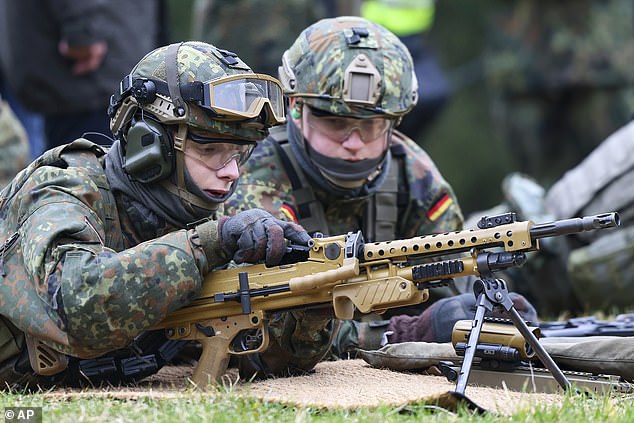
The report warns that German forces could face Russian forces. In the photo: soldiers training on February 28
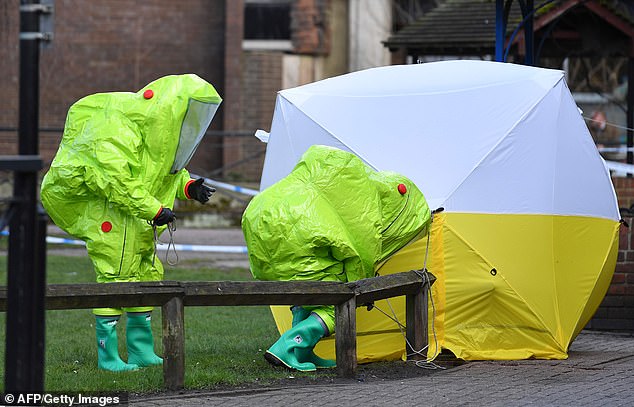
The report suggests there could be a repeat of the 2018 Salisbury poisonings (file image)
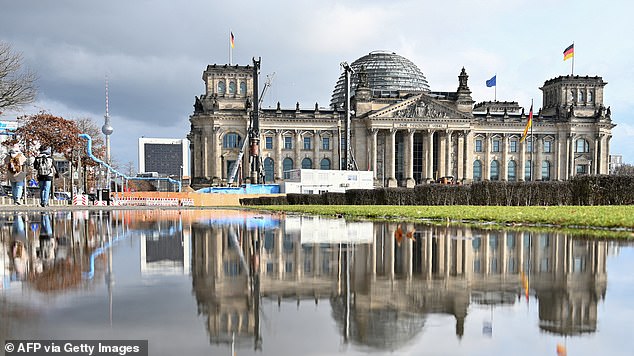
In the third phase, Russia could launch a conventional military attack on NATO members, even Germany (file image shows the Reichstag in Berlin)
“Experiences in recent years show that a potential aggressor may be willing to use unconventional weapons,” the report says.
“This was the case in Salisbury in 2018 and in Russia in 2020, where chemical attacks were carried out against individuals.”
Yesterday, Putin made a threat to bomb the West with nuclear weapons in his annual address to the nation, when he accused NATO and the US of “preparing to attack” Russia.
The Russian president, 71, said: “They, NATO and America, are of course active in other parts of the world, and they continue to lie there to deceive.
“They are preparing to attack our territory using the best possible forces, the most effective forces.
“But we remember the fate of those who try to invade our territory, and of course their fate will be far more tragic than anything we may encounter.”
Putin repeatedly praised Russia’s nuclear arsenal in his speech, adding as a warning to the West: “They must understand that we also have weapons, weapons that can defeat them on their own territory.”
‘All this is of course very dangerous, because it could actually lead to the use of nuclear weapons. Don’t they understand that?’
The Russian despot also assured that “strategic nuclear weapons are in a state of full readiness for guaranteed use,” but warned that the use of nuclear weapons would be tantamount to the “destruction of civilization.”
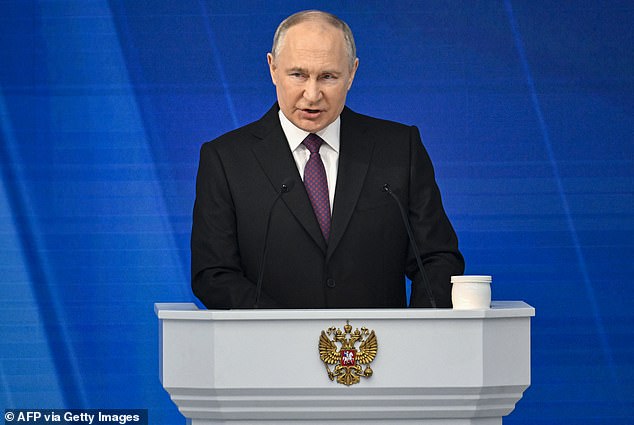
Russian President Vladimir Putin looks on as he delivers his annual speech to the Federal Assembly in Moscow, Russia, on February 29
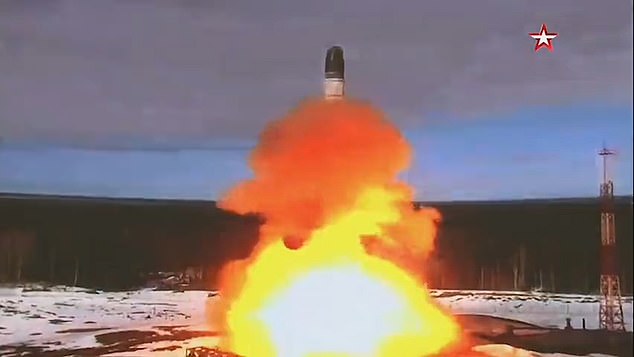
The Russian despot also chillingly assured that ‘strategic nuclear weapons are in a state of full readiness for guaranteed use’ (pictured here: Russian missile being launched)
Last month, German Defense Minister Boris Pistorius said in a stark warning: ‘We must take into account that Vladimir Putin will one day even attack a NATO country.
“Our experts expect a period of five to eight years in which this could be possible,” he told Der Tagesspiegel newspaper, before adding: “At the moment I don’t think a Russian attack is likely.”
However, secret German Defense Ministry documents leaked in January showed that the country is preparing for an attack by Vladimir Putin’s forces on NATO in 2025.
The documents provide a step-by-step doomsday guide to how Russia could escalate the conflict in Ukraine into all-out war in just 18 months.
German defense leaders are taking the threat from Moscow seriously, as the Bundeswehr prepares for a hybrid Russian attack on NATO’s eastern flank by the summer of 2025.
The secret document ‘Alliance Defense 2025’ details how Russia will mobilize another 200,000 soldiers before launching a spring offensive against Ukrainian forces this spring.
According to the leaked documents, by June, amid declining Western support and weapons, Russia would achieve success on the battlefield and make significant progress in Ukraine.
Speaking to MailOnline, retired Lieutenant General Ben Hodges warned that fears of all-out war are justified.
He said he believes that if countries do not take the threat from Russia “seriously” and act in “alliance,” World War III could develop in just 18 months.
Before Russia invaded Ukraine, Germany retreated from its defense commitments for decades, weighed down by its heavily militaristic past and its consequences in the twentieth century.
But the invasion changed Germany’s post-World War II pacifist policy and has since become the second-largest arms supplier to Ukraine.
